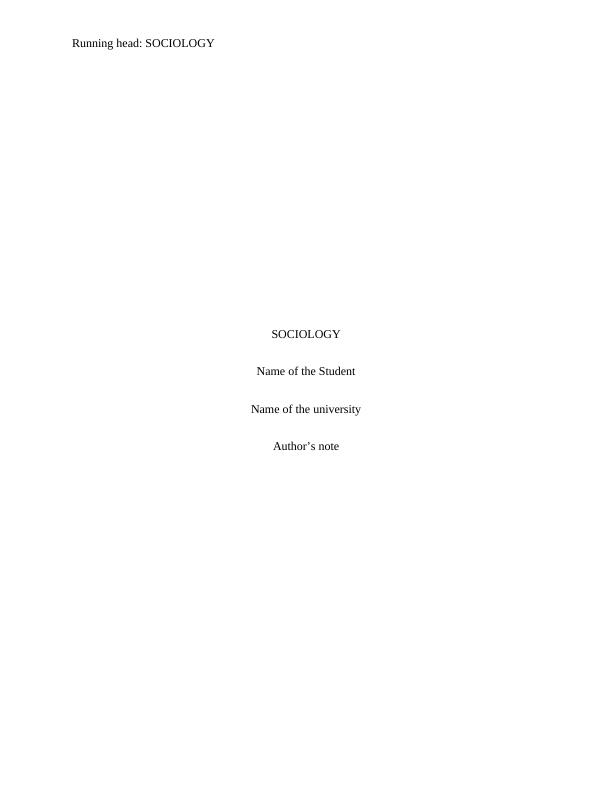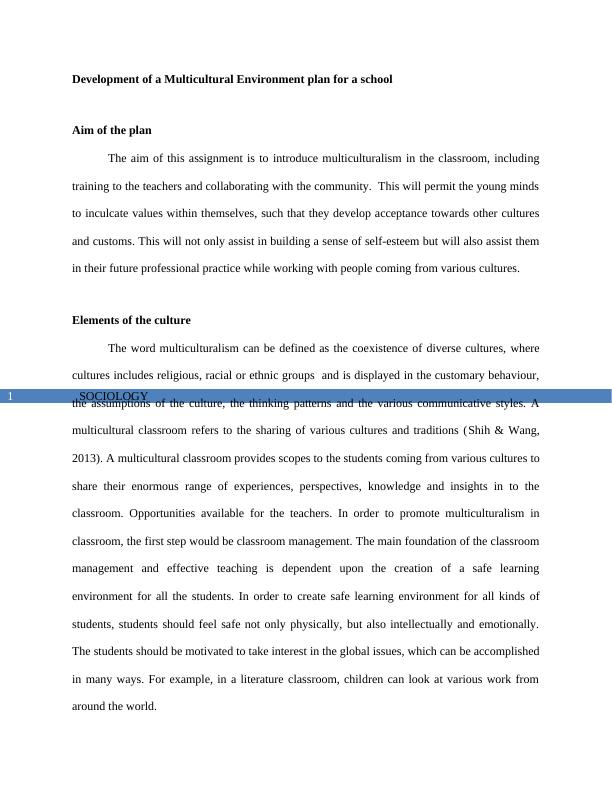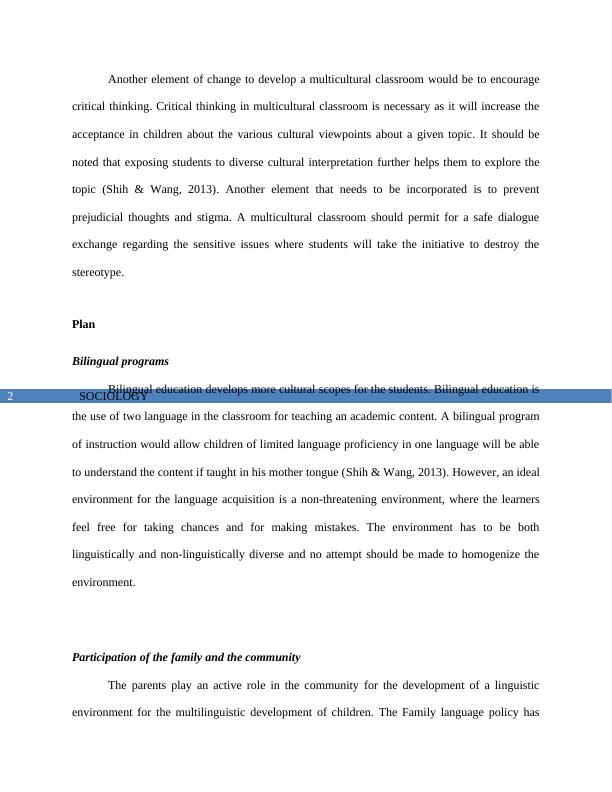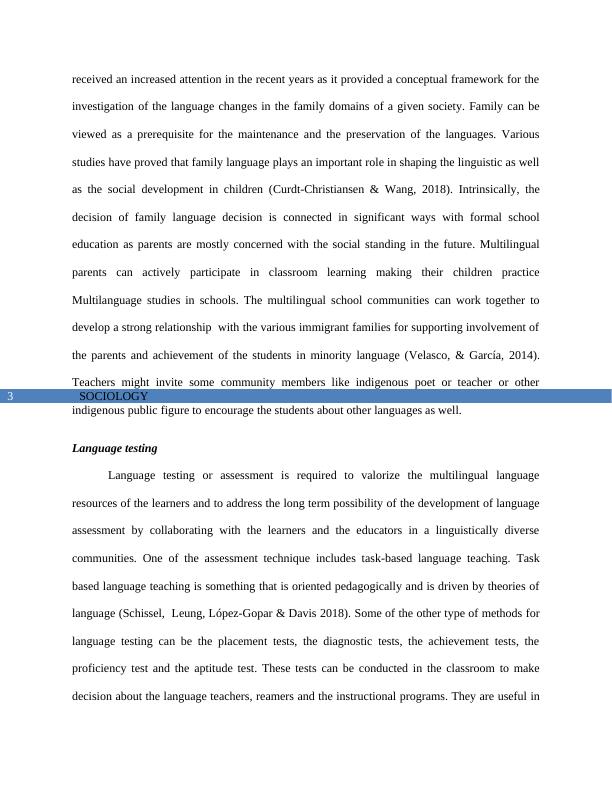International Convention on Information and Communication Technology
Added on 2022-08-20
11 Pages2737 Words32 Views
Running head: SOCIOLOGY
SOCIOLOGY
Name of the Student
Name of the university
Author’s note
SOCIOLOGY
Name of the Student
Name of the university
Author’s note

SOCIOLOGY1
Development of a Multicultural Environment plan for a school
Aim of the plan
The aim of this assignment is to introduce multiculturalism in the classroom, including
training to the teachers and collaborating with the community. This will permit the young minds
to inculcate values within themselves, such that they develop acceptance towards other cultures
and customs. This will not only assist in building a sense of self-esteem but will also assist them
in their future professional practice while working with people coming from various cultures.
Elements of the culture
The word multiculturalism can be defined as the coexistence of diverse cultures, where
cultures includes religious, racial or ethnic groups and is displayed in the customary behaviour,
the assumptions of the culture, the thinking patterns and the various communicative styles. A
multicultural classroom refers to the sharing of various cultures and traditions (Shih & Wang,
2013). A multicultural classroom provides scopes to the students coming from various cultures to
share their enormous range of experiences, perspectives, knowledge and insights in to the
classroom. Opportunities available for the teachers. In order to promote multiculturalism in
classroom, the first step would be classroom management. The main foundation of the classroom
management and effective teaching is dependent upon the creation of a safe learning
environment for all the students. In order to create safe learning environment for all kinds of
students, students should feel safe not only physically, but also intellectually and emotionally.
The students should be motivated to take interest in the global issues, which can be accomplished
in many ways. For example, in a literature classroom, children can look at various work from
around the world.
Development of a Multicultural Environment plan for a school
Aim of the plan
The aim of this assignment is to introduce multiculturalism in the classroom, including
training to the teachers and collaborating with the community. This will permit the young minds
to inculcate values within themselves, such that they develop acceptance towards other cultures
and customs. This will not only assist in building a sense of self-esteem but will also assist them
in their future professional practice while working with people coming from various cultures.
Elements of the culture
The word multiculturalism can be defined as the coexistence of diverse cultures, where
cultures includes religious, racial or ethnic groups and is displayed in the customary behaviour,
the assumptions of the culture, the thinking patterns and the various communicative styles. A
multicultural classroom refers to the sharing of various cultures and traditions (Shih & Wang,
2013). A multicultural classroom provides scopes to the students coming from various cultures to
share their enormous range of experiences, perspectives, knowledge and insights in to the
classroom. Opportunities available for the teachers. In order to promote multiculturalism in
classroom, the first step would be classroom management. The main foundation of the classroom
management and effective teaching is dependent upon the creation of a safe learning
environment for all the students. In order to create safe learning environment for all kinds of
students, students should feel safe not only physically, but also intellectually and emotionally.
The students should be motivated to take interest in the global issues, which can be accomplished
in many ways. For example, in a literature classroom, children can look at various work from
around the world.

SOCIOLOGY2
Another element of change to develop a multicultural classroom would be to encourage
critical thinking. Critical thinking in multicultural classroom is necessary as it will increase the
acceptance in children about the various cultural viewpoints about a given topic. It should be
noted that exposing students to diverse cultural interpretation further helps them to explore the
topic (Shih & Wang, 2013). Another element that needs to be incorporated is to prevent
prejudicial thoughts and stigma. A multicultural classroom should permit for a safe dialogue
exchange regarding the sensitive issues where students will take the initiative to destroy the
stereotype.
Plan
Bilingual programs
Bilingual education develops more cultural scopes for the students. Bilingual education is
the use of two language in the classroom for teaching an academic content. A bilingual program
of instruction would allow children of limited language proficiency in one language will be able
to understand the content if taught in his mother tongue (Shih & Wang, 2013). However, an ideal
environment for the language acquisition is a non-threatening environment, where the learners
feel free for taking chances and for making mistakes. The environment has to be both
linguistically and non-linguistically diverse and no attempt should be made to homogenize the
environment.
Participation of the family and the community
The parents play an active role in the community for the development of a linguistic
environment for the multilinguistic development of children. The Family language policy has
Another element of change to develop a multicultural classroom would be to encourage
critical thinking. Critical thinking in multicultural classroom is necessary as it will increase the
acceptance in children about the various cultural viewpoints about a given topic. It should be
noted that exposing students to diverse cultural interpretation further helps them to explore the
topic (Shih & Wang, 2013). Another element that needs to be incorporated is to prevent
prejudicial thoughts and stigma. A multicultural classroom should permit for a safe dialogue
exchange regarding the sensitive issues where students will take the initiative to destroy the
stereotype.
Plan
Bilingual programs
Bilingual education develops more cultural scopes for the students. Bilingual education is
the use of two language in the classroom for teaching an academic content. A bilingual program
of instruction would allow children of limited language proficiency in one language will be able
to understand the content if taught in his mother tongue (Shih & Wang, 2013). However, an ideal
environment for the language acquisition is a non-threatening environment, where the learners
feel free for taking chances and for making mistakes. The environment has to be both
linguistically and non-linguistically diverse and no attempt should be made to homogenize the
environment.
Participation of the family and the community
The parents play an active role in the community for the development of a linguistic
environment for the multilinguistic development of children. The Family language policy has

SOCIOLOGY3
received an increased attention in the recent years as it provided a conceptual framework for the
investigation of the language changes in the family domains of a given society. Family can be
viewed as a prerequisite for the maintenance and the preservation of the languages. Various
studies have proved that family language plays an important role in shaping the linguistic as well
as the social development in children (Curdt-Christiansen & Wang, 2018). Intrinsically, the
decision of family language decision is connected in significant ways with formal school
education as parents are mostly concerned with the social standing in the future. Multilingual
parents can actively participate in classroom learning making their children practice
Multilanguage studies in schools. The multilingual school communities can work together to
develop a strong relationship with the various immigrant families for supporting involvement of
the parents and achievement of the students in minority language (Velasco, & García, 2014).
Teachers might invite some community members like indigenous poet or teacher or other
indigenous public figure to encourage the students about other languages as well.
Language testing
Language testing or assessment is required to valorize the multilingual language
resources of the learners and to address the long term possibility of the development of language
assessment by collaborating with the learners and the educators in a linguistically diverse
communities. One of the assessment technique includes task-based language teaching. Task
based language teaching is something that is oriented pedagogically and is driven by theories of
language (Schissel, Leung, López-Gopar & Davis 2018). Some of the other type of methods for
language testing can be the placement tests, the diagnostic tests, the achievement tests, the
proficiency test and the aptitude test. These tests can be conducted in the classroom to make
decision about the language teachers, reamers and the instructional programs. They are useful in
received an increased attention in the recent years as it provided a conceptual framework for the
investigation of the language changes in the family domains of a given society. Family can be
viewed as a prerequisite for the maintenance and the preservation of the languages. Various
studies have proved that family language plays an important role in shaping the linguistic as well
as the social development in children (Curdt-Christiansen & Wang, 2018). Intrinsically, the
decision of family language decision is connected in significant ways with formal school
education as parents are mostly concerned with the social standing in the future. Multilingual
parents can actively participate in classroom learning making their children practice
Multilanguage studies in schools. The multilingual school communities can work together to
develop a strong relationship with the various immigrant families for supporting involvement of
the parents and achievement of the students in minority language (Velasco, & García, 2014).
Teachers might invite some community members like indigenous poet or teacher or other
indigenous public figure to encourage the students about other languages as well.
Language testing
Language testing or assessment is required to valorize the multilingual language
resources of the learners and to address the long term possibility of the development of language
assessment by collaborating with the learners and the educators in a linguistically diverse
communities. One of the assessment technique includes task-based language teaching. Task
based language teaching is something that is oriented pedagogically and is driven by theories of
language (Schissel, Leung, López-Gopar & Davis 2018). Some of the other type of methods for
language testing can be the placement tests, the diagnostic tests, the achievement tests, the
proficiency test and the aptitude test. These tests can be conducted in the classroom to make
decision about the language teachers, reamers and the instructional programs. They are useful in

End of preview
Want to access all the pages? Upload your documents or become a member.
Related Documents
Multi-cultural environment also provides social justicelg...
|8
|1870
|20
Impact of bilingual education on student achievementlg...
|10
|5520
|404
Principles and Practices of Socio-cultural Assessmentlg...
|3
|419
|87
Impact of Multiculturalism in Early Childhood Educationlg...
|16
|3749
|294
Culturally Responsive Teaching: Exploring Children’s Names and Cultural Identitieslg...
|3
|328
|20
Multiculturalism in Classroomlg...
|15
|4110
|350
